Firearms Technical Trivia, January 2000:
 |
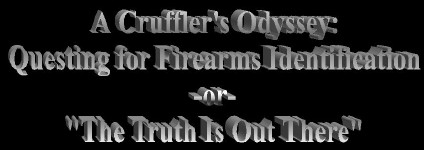 |
 |
One of the most maddening aspects of being a Cruffler, and yet at the same time, one of the most addictive, is the state of having a particular firearm in one's possession, but not being able to place it within a historical context. However, with a little thought, perseverance and research, a Cruffler can usually come fairly close to establishing a firearm's provenance. The intent of this article is to describe the basic necessities for researching a firearm, and to walk the reader through a brief example of such research.
There are a few prerequisites, tools of the trade, as it were, that should be on the Cruffler's "utility belt" as he or she starts out on this voyage of historical discovery. Foremost among these are some basic references. Books are as important as cleaning supplies in the Cruffler's universe. Reference volumes on firearms should include those that cover disassembly, history, and markings. Also included should be historical references. Without an awareness of the historical context, it is possible to miss many historical nuances that explain what may otherwise be puzzling attributes on a given firearm.
Additionally, the Cruffler should have a set of good quality tools with which to detail strip the firearm without marring the finish, buggering the screw heads, or splintering the stock. This tool set should include a set of gunsmith's screwdrivers, steel punches, brass punches, a brass and nylon headed hammer, a good penetrant for loosening time-welded screws, and possibly and impact driver.
Finally, the Cruffler should have time. You don't want to rush any part of the process. A hasty disassembly leads to a marred firearm. A gun that has weathered almost 100 years should be given enough respect so as not to damage it during take down! Also, you should give yourself enough time to complete your research before you come to any conclusions.
As an example of this process, let's take a look at a rifle CRUFFLER.COM received not too long ago. It was billed as a Spanish Mauser Model 1895 Cavalry Carbine, and it looks like this:
 |
While a good looking firearm, there were several questions that immediately popped up. For example: Why did this rifle exhibit action characteristics of the M1893 action instead if the M1895? Why were there no visible markings save the serial number on the receiver rail? When was it made? Who made it?
The first step in unraveling the mystery was to amass reference material. For this rifle, evidently a "mystery Mauser" the first step was to amass some references. The initial selection consisted (click on the link to order) of Rifles of the World, 2nd Edition, by John Walter, available from Amazon.com, Mauser Military Rifles of the World, by Robert Ball, available from Amazon.com, The Standard Directory of Proof Marks, by Gerhard Wirnsberger, available from IDSA Books, and Mauser Bolt Rifles, by Ludwig Olson, available from Brownells.
Next, the carbine was carefully detail stripped, using instructions found in Mauser Bolt Rifles. After detail stripping, we carefully cleaned the rifle so as to remove ancient grease and caked on dirt from all the parts. This was done with a soft cloth, bronze wool, and Shooter's Choice Bore Cleaner, the idea being to reveal any markings hidden by the dirt or grease.
After cleaning, a detailed inspection was conducted, and all markings, and their locations were noted. Here is what this inspection revealed:
We began the research phase with Olson's Mauser Bolt Rifles. Since this was ostensibly a Spanish Mauser Model 1895 Cavalry Carbine, we looked at Chapter 3 of the book, entitled "Development of the Mauser from 1888 to 1897." Turning to the section on the Spanish Model 93 Mauser, we found success! Underneath a photo of the carbine was the text:
- The rifle had been reblued at some point.
- The top of the receiver ring appeared slightly out of round, and this was consistent with the markings having been ground off that location.
- The left receiver rail aft of the receiver ring had been ground down such that there was noticeable thinning, again, consistent with having the markings removed from that location.
- The barrel serial number matched that of the bolt and receiver.
- The left side of the bolt shroud had been ground down, apparently to remove the original markings there.
- On the forward portions of the receiver, below the wood line of the stock, on both the left and right sides, were struck two identical proof marks consisting of flaming bombs with the letter E inside the bomb.
"According to an authoritative Spanish source, the carbine version of the Model 93 was not approved until 1895, and is properly known as the Model 95 despite the fact that many specimens bear an 1893 marking."So now there was confirmation that the carbine was indeed a Model 1895 Cavalry Carbine. However, this still didn't provide answers to the other question. Now, we turned to Ball's Mauser Military Rifles of the World, where we learned that the Model 1895 Carbine was indeed a "carbine model of the Model 1893 rifle." This explained why the action was that of a Model 1893. Further confirmation of this was received when we turned to Walter's Rifles of the World, where we learned that the Model 1895 Carbine was
"Adopted on 7th May, 1895, this was simply a short Mo. 1893, stocked to the muzzle, with a small rear sight and the bolt handle turned down."Reading further in Walter, we learned that some 22,500 Model 1895 Cavalry Carbines were made in Germany by Ludwig Loewe & Co. of Berlin between 1896 and 1897, and an indeterminate number by the Spanish National Arms Factory in Oviedo, Spain between 1896 and 1915.
Now we had the place of manufacture narrowed down to two places (Oviedo and Loewe), and a range of 19 years. Not bad for a piece with no ostensible markings! Was there anything that could narrow the range down further? Yes. There were the E in flaming bomb markings.
Picking up Wirnsberger's The Standard Directory of Proof Marks, we turned to the section on Spain. Sure enough, on the last page of the section on Spain was a picture of the E in a flaming bomb with the following explanation:
"Guns imported from a foreign country must carry proof marks accepted by the Spanish proof house. Should there be no acceptable proof marks on the gun, it must pass preliminary or provisional proof, then the suitable final proof. This mark is then applied to the barrel and other suitable parts of the action."Now THIS cleared a lot of things up! Since the mark indicated that this was a gun of foreign manufacture, it had to be one of the 22,500 made by Loewe between 1896 and 1897. Since the gun was made prior to 1899, it was legally classed as an antique! (NOTE: Before a Cruffler goes off and classifies a firearm as an antique, it is best to obtain a written determination that it is so from the BATF's Firearms Technology Division.)
Still a question, however, was the lack of any markings on the gun other than the serial number. The explanation for this came not from any text on or about firearms, but a historical footnote gleaned from works such as Hemingway's For Whom the Bell Tolls, Orwell's Homage to Catalonia, and Hugh Thomas' The Spanish Civil War.
The reign of King Alfonso XIII was ended in 1931 when the Spanish Republic was declared, and the king abdicated. Five years later, civil war broke out, and the Spanish Republic's government swung radically to the left, between Socialists, Anarchists, and Communists. To say that these people were antipathetic toward the monarchy, and any of its symbols would be an understatement. And so, like the Soviets in Russia, the Republicans sought to obliterate all symbols of the monarchy. This included the monarchist crest on the chambers of Spanish military longarms. And so, it is supposed that when Spanish longarms were refurbished by the Republic's arsenals, the chamber crests, side rail markings, and other serial numbers were obliterated by grinding and a subsequent refinishing.
As you can see, giving an identity to a firearm is a drawn out process that can require patience and perseverance, but in the end, it is well worth it. The old firearms begin to take on a life of their own and tie you into history in a way you never imagined!
Note: Data for this month's trivia page was gathered from:
Ball, Robert W. D., Mauser Military Rifles of the World, Krause Publications (Iola, Wisconsin, 1996) ISBN 0-87341-395-4
Olson, Ludwig, Mauser Bolt Rifles, Brownell & Son (Montezuma, Iowa, 1991)
Walter, John, Rifles of the World, 2nd Edition, Krause Publications (Iola, Wisconsin, 1996) ISBN 0-87349-202-1
Wirnsberger, Gerhard, The Standard Directory of Proof Marks, Blacksmith Publishers Corporation (Chino Valley, Arizona) ISBN 0-89149-006-X
Mauser
Military Rifles of the World is available from Amazon.com.
Click on the image to order:
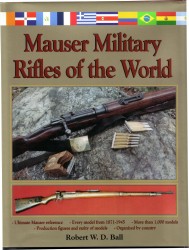
Mauser
Bolt Rifles is available from Brownells. Click on
the image to order:
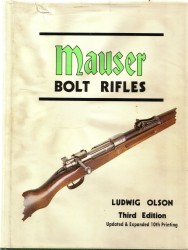
Rifles
of the World is available from Amazon.com. Click on the
image to order:
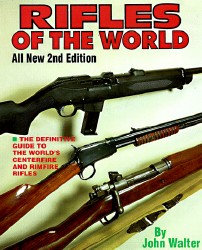
The
Standard Directory of Proof Marks is available from IDSA Books.
Click on the image to order:
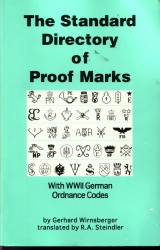
|
|